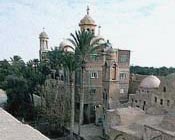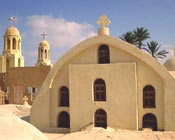|
Wadi Natroun
The quasi-oasis of Wadi Natroun, just off the Desert Road
between Cairo and Alexandria, takes its name -and oasis nature- from deposits of natron salts, the main ingredient in
ancient mummifications
The four Wadi Natroun monasteries have all been totally ruined
and rebuilt at least once since their foundation during the
fourth century. Each has a high wall surrounding one or more
churches, a central keep entered via a drawbridge, containing a
bakery, storerooms and wells enabling the monks to withstand
siege, and diverse associated chapels.
Their fortified exteriors, necessary in centuries past to resist
Bedouin raiders, cloak what are today very forward-looking,
purposeful monastic establishments.
Deir Anba Bishoi
:
 Deir Anba Bishoi is the most accessible monastery only 10km from
the highway. It contains five churches, the oldest of which is
St. Bishoi’s which features three “haikals” sanctuaries dating
from the fourth, ninth and tenth centuries. There’s also a
fifth-century well where Berber tribesmen washed their swords
after massacring the 49 Martyrs of the monastery of St.
Makerinus. The multi-domed building furthest away from the
entrance is the residence of Pope Shenouda III, the current
Coptic Pope. Most of the Coptic popes have been chosen from the
monks of Wadi Natroun and Deir Anba Bishoi in particular. Deir Anba Bishoi is the most accessible monastery only 10km from
the highway. It contains five churches, the oldest of which is
St. Bishoi’s which features three “haikals” sanctuaries dating
from the fourth, ninth and tenth centuries. There’s also a
fifth-century well where Berber tribesmen washed their swords
after massacring the 49 Martyrs of the monastery of St.
Makerinus. The multi-domed building furthest away from the
entrance is the residence of Pope Shenouda III, the current
Coptic Pope. Most of the Coptic popes have been chosen from the
monks of Wadi Natroun and Deir Anba Bishoi in particular.
Deir Al-Suryani :
 Deir Al-Suryani was named after a group of Syrian monks who used
to live there. Its principal church of the Virgin was built
around 980 and contains a sanctuary with stucco ornamentation
and a superb ebony “Door of Prophecies” inlaid with ivory panels
depicting the disciples and the seven epochs of the Christian
era. dark passage-way at the back of the church leads to the
cave where Bishoi tied his hair to a chain hanging from the
ceiling to prevent himself sleeping for four days until a vision
of Christ appeared. he monastery has a modern library in which
the monastery’s antique volumes are lovingly maintained. Deir Al-Suryani was named after a group of Syrian monks who used
to live there. Its principal church of the Virgin was built
around 980 and contains a sanctuary with stucco ornamentation
and a superb ebony “Door of Prophecies” inlaid with ivory panels
depicting the disciples and the seven epochs of the Christian
era. dark passage-way at the back of the church leads to the
cave where Bishoi tied his hair to a chain hanging from the
ceiling to prevent himself sleeping for four days until a vision
of Christ appeared. he monastery has a modern library in which
the monastery’s antique volumes are lovingly maintained.
Deir El-Baramus :
 Deir El-Baramus lies 4 km north to Deir Anba Bishoi. This
monastery was found by St. Makarius in 340making it the oldest
of the four moanstries of Wadi Natroun. Its Name “Monastery of
the Romans” honours Maximus and Domidus , two sons of the Roman
Emperor Valentinus who died from excessive fasting. Their bodies
were buried in a crypt below the Church of the Virgin.
Restoration works have revealed layers of medieval frescoes in
the nave, the western end of which incorporates a fourth-century
pillar with Syriac inscriptions. The ninth-century church shares
a vine-laden courtyard with a keep and four other churches. Deir El-Baramus lies 4 km north to Deir Anba Bishoi. This
monastery was found by St. Makarius in 340making it the oldest
of the four moanstries of Wadi Natroun. Its Name “Monastery of
the Romans” honours Maximus and Domidus , two sons of the Roman
Emperor Valentinus who died from excessive fasting. Their bodies
were buried in a crypt below the Church of the Virgin.
Restoration works have revealed layers of medieval frescoes in
the nave, the western end of which incorporates a fourth-century
pillar with Syriac inscriptions. The ninth-century church shares
a vine-laden courtyard with a keep and four other churches.
Deir Abu Maqar :
 Deir Abu Maqar is the oldest and the furthest of the monasteries
founded by St Makarius who died in 390. It lies 18km southwest
of St. Bishoi. It is enclosed by a circular wall ten meters
high. In times past, two giant millstones stood ready to be
rolled across to buttress the door against Beduin raiders. Since
its nadir in 1969, when only six monks lived here, the monastery
has acquired a hundred brethren, a modern printing press and a
farm employing 600 workers. The monks have also mastered
pinpoint irrigation systems and bovine embryo transplant
technology. Deir Abu Maqar is the oldest and the furthest of the monasteries
founded by St Makarius who died in 390. It lies 18km southwest
of St. Bishoi. It is enclosed by a circular wall ten meters
high. In times past, two giant millstones stood ready to be
rolled across to buttress the door against Beduin raiders. Since
its nadir in 1969, when only six monks lived here, the monastery
has acquired a hundred brethren, a modern printing press and a
farm employing 600 workers. The monks have also mastered
pinpoint irrigation systems and bovine embryo transplant
technology. |